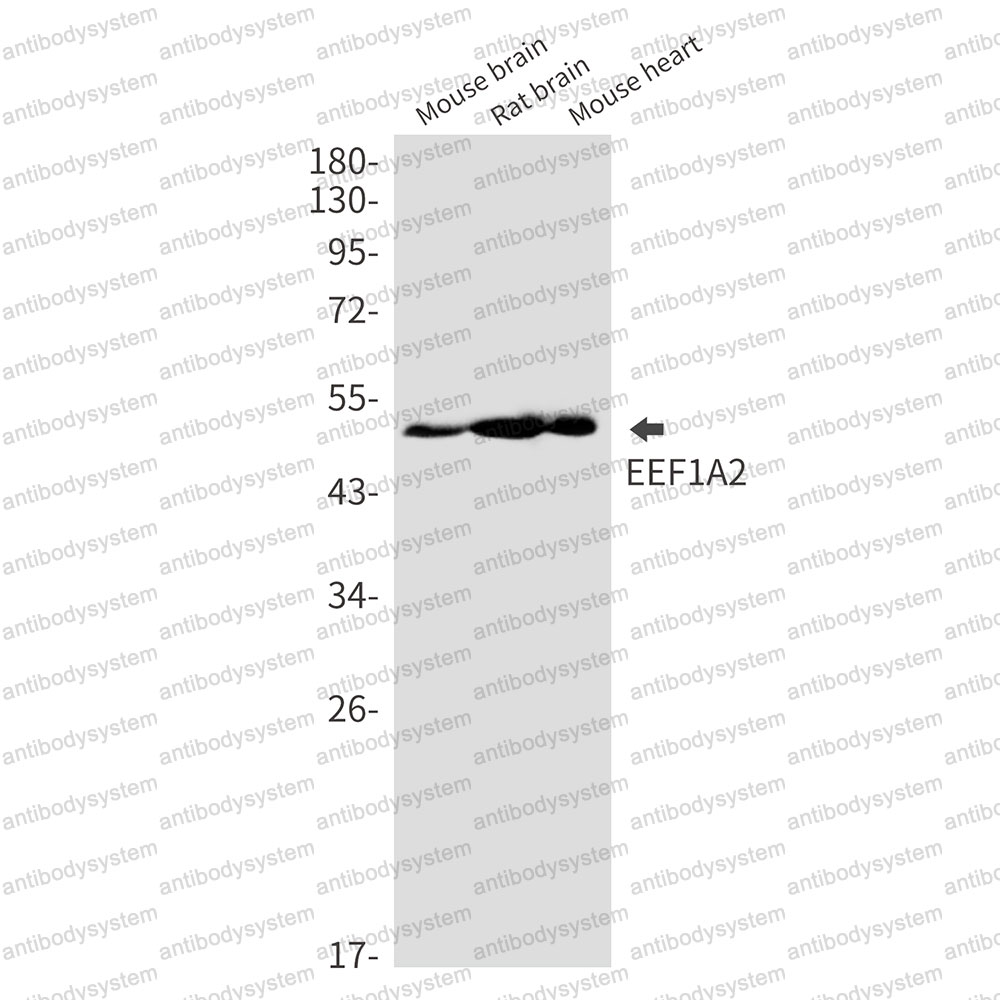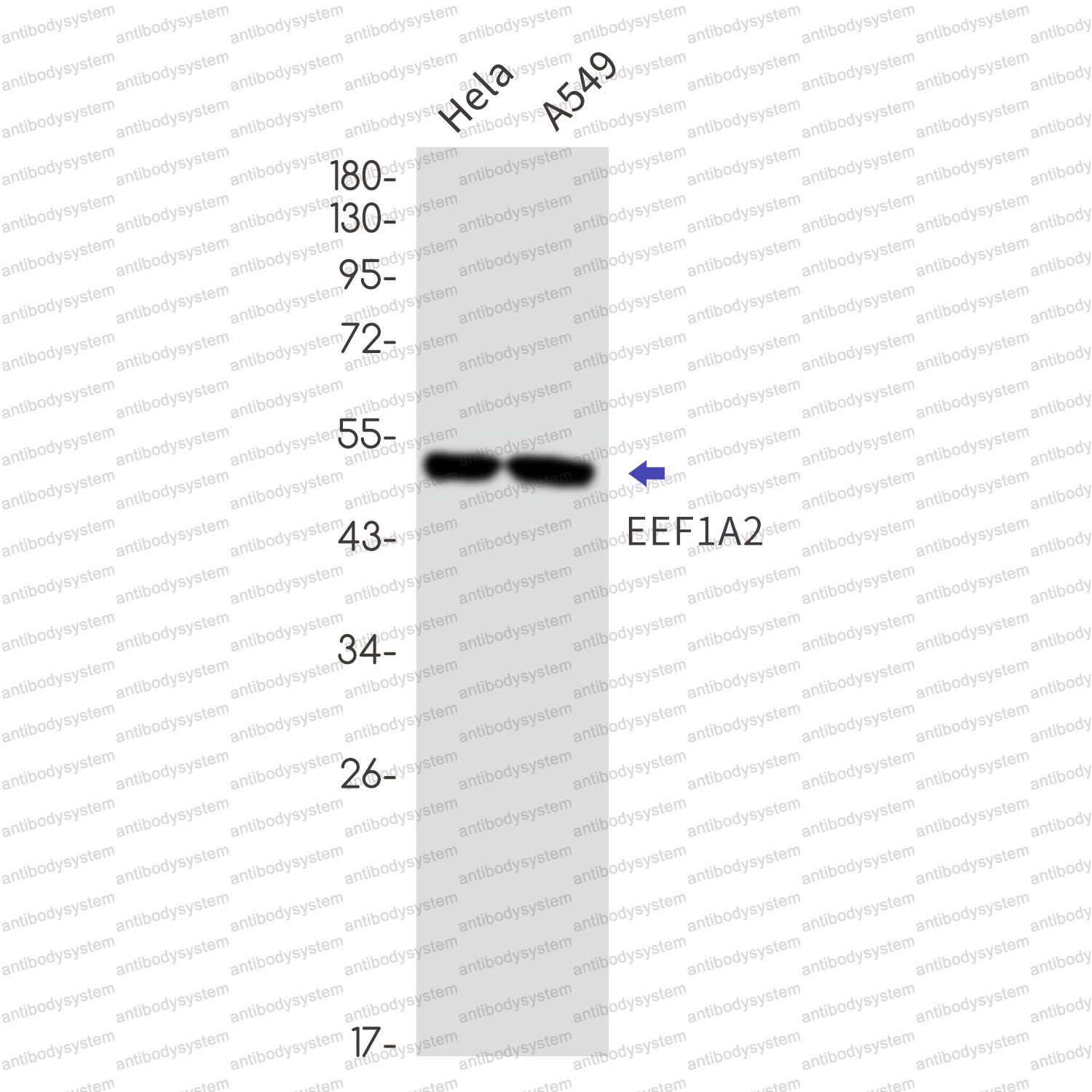Catalog No.
RHG05401
Species reactivity
Human, Mouse, Rat
Host species
Rabbit
Isotype
IgG
Clonality
Monoclonal
Tested applications
IP: 1:20, WB: 1:500-1:1000
Target
Elongation factor 1-alpha 2, EEF1AL, Eukaryotic elongation factor 1 A-2, eEF1A-2, EF-1-alpha-2, Statin-S1, STN, EEF1A2
Concentration
1 mg/ml
Endotoxin level
Please contact with the lab for this information.
Purity
>95% by SDS-PAGE.
Purification
Protein A/G purified from cell culture supernatant.
Accession
Q05639
Applications
IP, WB
Form
Liquid
Storage buffer
0.01M PBS, pH 7.4, 0.05% BSA, 50% Glycerol, 0.05% Sodium azide.
Stability and Storage
Use a manual defrost freezer and avoid repeated freeze thaw cycles. Store at 4 ℃ for frequent use. Store at -20 ℃ for twelve months from the date of receipt.
Clone ID
R2C66
Endogenous epitope tagging of eEF1A2 in mice reveals early embryonic expression of eEF1A2 and subcellular compartmentalisation of neuronal eEF1A1 and eEF1A2., PMID:37429391
Analysis of the Expression and Subcellular Distribution of eEF1A1 and eEF1A2 mRNAs during Neurodevelopment., PMID:35741005
Targeted Therapies for Multiple Myeloma., PMID:33922567
Tumor suppressor DRD2 facilitates M1 macrophages and restricts NF-κB signaling to trigger pyroptosis in breast cancer., PMID:33859743
Identification of loci associated with susceptibility to bovine paratuberculosis and with the dysregulation of the MECOM, eEF1A2, and U1 spliceosomal RNA expression., PMID:33432064
A rapid and specific method to simultaneously quantify eukaryotic elongation factor 1A1 and A2 protein levels in cancer cells., PMID:31450069
[Preparation of monospecific antibodies against isoform 2 of translation elongation factor 1A (eEF1A2)]., PMID:24749247
Dissecting the expression of EEF1A1/2 genes in human prostate cancer cells: the potential of EEF1A2 as a hallmark for prostate transformation and progression., PMID:22095224
eEF1A phosphorylation in the nucleus of insulin-stimulated C2C12 myoblasts: Ser⁵³ is a novel substrate for protein kinase C βI., PMID:20923971
Resveratrol suppresses growth of human ovarian cancer cells in culture and in a murine xenograft model: eukaryotic elongation factor 1A2 as a potential target., PMID:19738051
The prognostic significance of elongation factor eEF1A2 in ovarian cancer., PMID:18164751
Characterization of a putative ovarian oncogene, elongation factor 1alpha, isolated by panning a synthetic phage display single-chain variable fragment library with cultured human ovarian cancer cells., PMID:17908984
Translation elongation factor eEF1A2 is essential for post-weaning survival in mice., PMID:17640869
Expression of eEF1A2 is associated with clear cell histology in ovarian carcinomas: overexpression of the gene is not dependent on modifications at the EEF1A2 locus., PMID:17437010
Expression of protein elongation factor eEF1A2 predicts favorable outcome in breast cancer., PMID:16897428
Aromatase inhibitors increase the sensitivity of human tumor cells to monocyte-mediated, antibody-dependent cellular cytotoxicity., PMID:16164922
Translation elongation factor eEF1A2 is a potential oncoprotein that is overexpressed in two-thirds of breast tumours., PMID:16156888
Immuno-characterization of the switch of peptide elongation factors eEF1A-1/EF-1alpha and eEF1A-2/S1 in the central nervous system during mouse development., PMID:15013623
Changes in protein levels of elongation factors, eEF1A-1 and eEF1A-2/S1, in long-term denervated rat muscle., PMID:12808202
Generation and epitope mapping of high-affinity scFv to eukaryotic elongation factor 1A by dual application of phage display., PMID:11422370
Cell cycle distribution of cord blood-derived haematopoietic progenitor cells and their recruitment into the S-phase of the cell cycle., PMID:10759722
All-trans retinoic acid (ATRA)-induced apoptosis is preceded by G1 arrest in human MCF-7 breast cancer cells., PMID:9460987
The expression of proliferation and quiescence associated antigens in acute myeloid leukemia correlates with survival duration: analysis of 15 refractory cases., PMID:9234585
Immunohistochemical analysis of statin in colorectal adenocarcinoma, polyps, and normal mucosa., PMID:8620806
Predictive value of statin, a G0-associated cell cycle protein, in childhood acute lymphoblastic leukemia., PMID:7622304
Expression of proliferation-specific genes in the mucosa adjacent to colon carcinoma., PMID:7736875
Proliferative activity at colonic anastomoses as determined by statin. A nonproliferation-specific nuclear protein., PMID:8200231
Characterization of 57 kDa statin as a true marker for growth arrest in tissue by its disappearance from regenerating liver., PMID:8106565
Cell cycle kinetic effects of tamoxifen on human breast cancer cells. Flow cytometric analyses of DNA content, BrdU labeling, Ki-67, PCNA, and statin expression., PMID:7904138
The differential expression of statin in the nuclei of human colonic crypts adjacent to a cancer: an immunohistochemical study., PMID:7682866
Statin, a protein specifically present in nonproliferating cells, is a phosphoprotein and forms a complex with a 45-kilodalton serine/threonine kinase., PMID:1400486
Proliferative activity of colonic mucosa at different distances from primary adenocarcinoma as determined by the presence of statin: a nonproliferation-specific nuclear protein., PMID:1511650
Histochemical localization of Statin--a non-proliferation-specific nuclear protein--in nuclei of normal and abnormal human thyroid tissue., PMID:1380846
Statin immunolocalization in human brain tumors. Detection of noncycling cells using a novel marker of cell quiescence., PMID:1855178
Isolation and characterization of the rat chromosomal gene for a polypeptide (pS1) antigenically related to statin., PMID:1709933
Statin expression in the untreated and SarCNU-exposed human glioma cell line, SK-MG-1., PMID:2208582
Statin, a nonproliferation-specific protein, is associated with the nuclear envelope and is heterogeneously distributed in cells leaving quiescent state., PMID:2674158
The disappearance of a cyclin-like protein and the appearance of statin is correlated with the onset of differentiation during myogenesis in vitro., PMID:2892689
Contact-inhibition-induced quiescent state is marked by intense nuclear expression of statin., PMID:3312241
Rapid disappearance of statin, a nonproliferating and senescent cell-specific protein, upon reentering the process of cell cycling., PMID:3902853
A 57,000-mol-wt protein uniquely present in nonproliferating cells and senescent human fibroblasts., PMID:3968178


